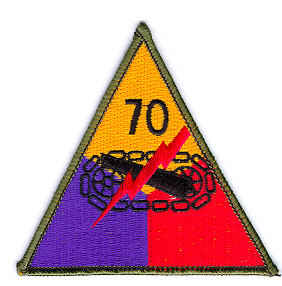
THE 70TH TANK BATTALION REENACTMENT UNIT
UNIT PURPOSE AND GOAL
The purpose of the 70th Tank Battalion reenactment unit is to portray the military life of the typical armored vehicle crewman during World War II. Portrayal venues include public display battles, living history static displays, private tactical battles and W.W.II related dances. The goal is to transfer historical knowledge of W.W.II armored units to the public, historians and the military.
THE HISTORY OF THE 70TH INDEPENDENT TANK BATTALION
Just before WWII, U.S. military planners formulated doctrine
where armored forces would be divided into two major units:
heavily armed divisions for major assaults against enemy
formations and independent tank battalions for infantry support.
The independent tank battalion was a small, self contained,
armored unit that would be attached to infantry divisions when the
need arose. This allowed the armored divisions to remain intact
while the smaller independent tank battalions would often be
separated into company sized units attached to an infantry
regiment. It was not unusual for a single tank from an independent
tank battalion to be assigned to an infantry company. The 70th
Tank Battalion was the first to be formed in July 1940. When war
was declared, the 70th was one of the few trained tank units
available for combat. Since the unit was stationed on the East
Coast of the U.S., military planners expected to assign missions to
the 70th in the European/North African Theatres. Other
independent tank battalions in the Wisconsin area were assigned
the defense of the Philippians in the Southeastern Theatre. The
first mission of the 70th was to accompany an amphibious force to
capture Martinique, an island in the West Indies ruled by the Vichy
French. Their P40 War Hawk squadron posed a significant threat
to the area at the time. The 70th was one of the few, trained
armored units at the time, so Company A was detached and
accompanied the 1st Infantry Division and 1st Marine Raider
Battalion on the mission. The Vichy French capitulated, and the
Allies occupied Martinique. Company C of the 70th was detached
to Iceland to protect against a German invasion.
The next significant deployment of the 70th was during the
invasion of North Africa -Operation Torch. The 70th came ashore
with the 9th Infantry Division and experienced combat for the first
time. After surrender of the Vichy French forces, the 70th was
ordered to train the free French Army on the use of the new M5
light tank. Early battles in North Africa were rough for the 70th.
Infantry commanders were not trained in the use of tanks and often
used them recklessly and inefficiently, sometimes as bait and
sometimes as sacrificial "lambs." Realizing this intolerable
condition, several 70th company commanders insisted on being in
on attack planning. This resulted in a quick education of infantry
commanders on tank warfare, a sense of cooperation between
infantry and armor, and rapport between infantry and tankers.
Cooperation on assaults was effective and lead to may battles won
for the Allies. At the end of the North African Campaign,
Company A of the 70th Tank Battalion and an infantry company
accepted the surrender of between 8500 and 9500 German and
Italian infantry. The Germans and Italians all marched out of their
positions to surrender. So many surrendered that if they had
decided to renege, they surely could have captured the entire
Allied force. It was obvious that the Axis forces were tired and out
of supplies and perhaps looked forward to spending the remaining
year of the war in POW camps in Arizona.
Military planners decided on Sicily as the next target, and assigned
the battle hardened 70th to support the 1st Infantry Division. At the
time, the 70th still had the M5A1 light tanks and the M3 75mm
Gun Motor Carriage as their main equipment. The invasion was
successful and the 70th performed well, relying on tactics
developed in the field and not current military manuals. In one
encounter, several PzHpfw IV (Mark 4) tanks were in column
traveling down a road to counterattack the invasion force. This was
the first time that the whole battalion was together as a unit under
the command of Lt. Col. Welborn. 70th tanks, deployed on high
ground, popped over ridges, shot down on the light top armor of
the Mark 4 (first top attack technique) then disappeared before the
German gunners could lay a sight on the M5's. Several Mark 4's
were knocked out and the remaining retreated. This was a typical
example of superior tactics that often made up for deficiencies in
U.S. tank design.
After Sicily, the 70th went to England to prepare for the Overlord
amphibious landing. The experienced 70th was attached to help the
inexperienced 4th Infantry Division. The 70th was supplied with the
new M4 Sherman Duplex Drive Tank (DD). This tank was
equipped with a flotation skirt and 2 propellers, making it an
amphibious tank. In the upgraded 70th, three companies had the
M4 medium tank, while one company had the M5A1 light tank.
Several officers of the 70th were skeptical as to the seaworthiness
of the DD tank and spent their own time and money upgrading the
flotation by reinforcing certain areas. At Utah beach, the 70th
landed 28 DD tanks with a loss of only 4 (their LST hit a mine and
sank). The tanks were valuable in supporting infantry and
punching through the defensive walls. The 4th Infantry Division
and the 70th quickly developed cooperative tactics. 70th dozer tanks
would plow up embankments for infantry cover while the infantry
would neutralize hand-held, anti-tank weapons such as the panzer
foust and panzer shrek. The assault through the hedgerow country
was murderous for the 70th and the 4th. One effective tactic,
developed by the 70th, was to use the dozer tanks to plow down the
hedgerows so the tanks and infantry could break through without
becoming exposed when traveling up and over the hedgerows.
The 70th then turned toward Paris. Photo 1 is a view of a 70th Tank
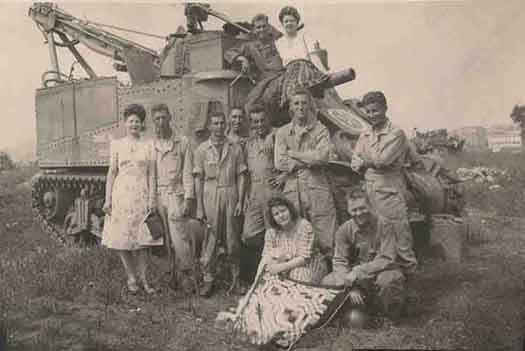
Photo 1
Battalion tank retriever crew after the liberation of Paris. Notice
the old M3 Grant, which was typically relegated to retrieval roles.
After the Paris liberation, hedgerow country was still a major
problem. The hedgerow country favored the defenders. The
Germans would usually have a formidable tank, such as a Tiger or
Panther, hidden at a road intersection. As soon as an M4 appeared,
it would be destroyed, stalling the assault. Then, the zeroed-in
locations would be hit with a mortar barrage, causing many Allied
casualties. It was disgraceful that the U.S. Army Ordnance
Department had not corrected the major deficiencies of the M4
(insufficient muzzle velocity of the main gun, inadequate armor
and fire hazard) by that time in the war. The prevailing strategy
was to overwhelm the enemy with numbers as opposed to
technological superiority. Close air support alleviated the problem,
with aircraft knocking out or damaging enemy armor prior to an
assault.
The 70th was involved in several battles including the Huertgen
Forest and the Ardennes Offensive (Battle of the Bulge). During
the Ardennes Offensive, B Company of the 70th was moving up
with A Company from the 4th Infantry Division to rescue a
surrounded infantry company, when suddenly a German infantry
unit was spotted moving down a long hilly pasture. The Germans
were caught in a difficult position with no cover. The 70th opened
up with machine gun and AP rounds. The action concluded with
the German unit wiped out with few Allied casualties. This was the
text book type of action envisioned by military planners at the
time, where tanks would support infantry action. Unfortunately
tank vs. tank battles were not envisioned by U.S. military
doctrinaires, to the detriment of many tank units. Tank Destroyer
Units (TD) were supposed to neutralize the enemy tanks.
The 70th Tank Battalion ended WWII just south of Munich,
Germany. Photo 2 shows Company D, 70th Tank Battalion in
Nuremberg, Germany in 1945.

Photo 2
The 70th Tank Battalion served in the following campaigns:
Algeria-French Morocco, Tunisia, Sicily, Normandy, Northern
France, Rhineland, Ardennes-Alsace and Central Europe. The 70th
Tank Battalion was one of the most decorated tank units because
of participation in eight campaigns. The 70th Independent Tank
Battalion was retired after the war and lives on in the 70th Tank
Battalion Association. The 70th Heavy Tank Battalion was formed
during the Korean War, but is a separate unit.
The unit patch is shown above. It is typical of armor patches and can be either armor unassigned or the armor patch with the number 70 at the top corner of the triangle.

FIGURE 1

FIGURE 2
The mascot is shown in Figure 1 and is a turtle dressed in armor paraphernalia. The name of the mascot is Joe Peckerwood. The unit crest is shown in Figure 2. The arrows represent tanks in an armored formation with the motto, “Strike Swiftly”. Unit decorations include Presidential unit citation (twice), Belgian Fourragere, and Bravery Gold Metal of Greece. (References 1 and 2). Reference 1 is an excellent detailed history of the 70th Tank Battalion.
TANKER UNIFORMS
Armored unit uniforms varied throughout the war years as well as with the variety of armored vehicles used.
For the turreted vehicles such as the M5A1 light tank, early war uniforms consisted of a
khaki shirt, pants, and necktie, brown combat boots, crash helmet with goggles, web pistol belt and 45 Cal Pistol on belt.
In mid to late war herringbone twill (HBT) coveralls, crash helmet with goggles and radio headset with pigtail were utilized.
Brown combat boots, leggings(optional) and 45 Cal pistol on web belt or shoulder holster typified the armored crewman.
The M1 Helmet was also used in turreted vehicle but was more prevalent in armored support vehicles such as halftracks
where the tanker crash helmet was not used.
Figure 3 shows a typical early war tanker’s uniform with the kahki shirt, tie and crash helmet. High boots typical of cavalry units of that era were also used. Figure 4 is a view of the mid and late war tanker’s uniform with standard issue combat boots, crash helmet and goggles. HBT coveralls were typically used, although the standard infantry wood shirt and trousers were sometimes used. Firearms were the Cal 45 pistol, M1 carbine or submachine gun. During the early war, radio headsets were not used. During mid and late war, a variety of radio headsets were used. Armor patch was worn on the left sleeve, one half inch below the shoulder as shown in Figure 4. The NCO in Figure 4 is wearing HBT pants and shirt, along with the M1941 field jacket. Early war crash helmets did not incorporate radio gear. Mid war crash helmets utilized head phones and the T-17 microphone. Late war crash helmets utilized the throat microphone. Some armored crews used leggings, others did not. Leggings have the propensity of snagging on metallic protrusions found in tanks. Many armored crews simply tucked the coveralls into the boots or allowed them to cover the boots using the buttoned flap at the bottom of the coveralls as shown in Figure 4.
Winter uniform included bib-fronted over trousers in pale olive drab and tanker’s winter combat jacket as shown Figure 5.
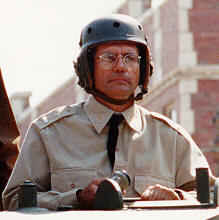 FIGURE 3
FIGURE 3
 FIGURE 4
FIGURE 4
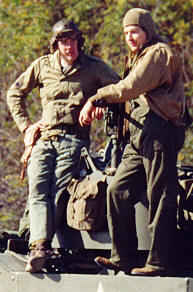 FIGURE 5
FIGURE 5
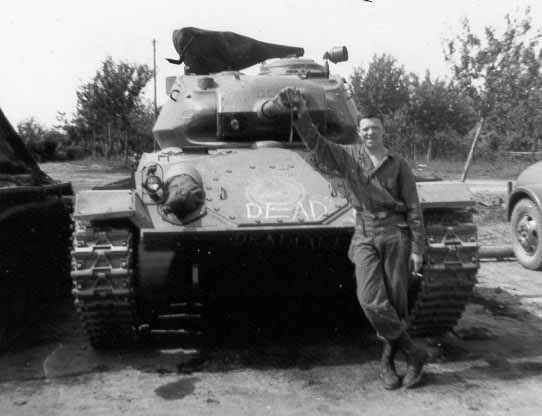
Edward Manohan, U.S. Constabulary, Schweinfurt, Germany, 1946 in tanker HBT
REFERENCES
1. Jensen, Marvin G., “STRIKE SWIFTLY, A History of the 70th Tank Battalion”, Presidio Press, 1997.
2. Matloff, Maurice ,“ARMOR CAVALRY”, Office of the Chief of Military History,
Washington DC, 1972.

IF YOU ARE INTERESTED IN PARTICIPATING IN WWII REENACTMENTS IN AN ARMORED OR INFANTRY UNIT, PLEASE CONTACT ROBERTS ARMORY FOR DETAILS AND AN APPLICATION
Copyright 1995 Charles C. Roberts, Jr






 FIGURE 3
FIGURE 3
 FIGURE 4
FIGURE 4
 FIGURE 5
FIGURE 5

 BACK TO ROBERTS ARMORY HOME PAGE
BACK TO ROBERTS ARMORY HOME PAGE